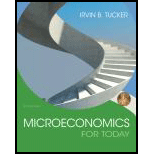
The short run advice to the firm.
Answer to Problem 1KC
Option 'c' is correct.
Explanation of Solution
The firms produce the goods and services that are demanded by the people in the economy. The production takes place after making use of the factors of production and that means there will be factor costs to the firm while making production. The costs such as the cost of the raw materials, rent of land, interest on capital, as well as the wage of labor, are the costs of the firm. The additional output due to an additional input of production is known as the marginal product of the input. The profit is the excess revenue made by the firm after deducting the total cost from the total revenue of the firm. When the total cost is higher than the total revenue, there will be an economic loss to the firm. When the revenue of the firm is not even able to cover the
Option (c):
It is given that the average fixed cost of the firm is $6 and the average variable cost is $25. When the price of the product is fixed at $24 where MR is equal to MC, the revenue is not even able to cover the AVC of the firm and carrying on further production will increase the loss above the fixed cost and thus, the firm should shut down. This means that option 'c' is correct.
Option (a):
When the firm increases the output, the point where MR is equal to MC, MC will start to increase further which will increase the loss of the firm and that means the loss of the firm will further increase. Hence, option 'a' is incorrect.
Option (b):
The decreasing of output makes the firm to get lower revenue and since the average variable cost is higher, the firm should shut down its operations and not decrease the level of output. It means option 'b' is also incorrect.
Option (d):
When the firm stays at the current output level, the total cost to the firm is $6200, whereas the revenue is $4800 which means that the firm is losing $1,400 and not earning a profit of $1,400. Hence, option 'd' is incorrect.
Option (d):
When the firm stays at the current output level, the total cost to the firm is $6200, whereas the revenue is $4800 which means that the firm is losing $1,400 and if the firm shutdowns its production, it makes the loss only equal to the fixed cost and thus, the firm should shut down its operations. This means that option 'd' is incorrect.
Profit: The profit is the excess revenue made by the firm through the sale of goods and services after deducting the total cost from the total revenue.
Want to see more full solutions like this?
Chapter P3 Solutions
Microeconomics For Today (MindTap Course List)
- You are the manager of a large automobile dealership who wants to learn more about the effective- ness of various discounts offered to customers over the past 14 months. Following are the average negotiated prices for each month and the quantities sold of a basic model (adjusted for various options) over this period of time. 1. Graph this information on a scatter plot. Estimate the demand equation. What do the regression results indicate about the desirability of discounting the price? Explain. Month Price Quantity Jan. 12,500 15 Feb. 12,200 17 Mar. 11,900 16 Apr. 12,000 18 May 11,800 20 June 12,500 18 July 11,700 22 Aug. 12,100 15 Sept. 11,400 22 Oct. 11,400 25 Nov. 11,200 24 Dec. 11,000 30 Jan. 10,800 25 Feb. 10,000 28 2. What other factors besides price might be included in this equation? Do you foresee any difficulty in obtaining these additional data or incorporating them in the regression analysis?arrow_forwardsimple steps on how it should look like on excelarrow_forwardConsider options on a stock that does not pay dividends.The stock price is $100 per share, and the risk-free interest rate is 10%.Thestock moves randomly with u=1.25and d=1/u Use Excel to calculate the premium of a10-year call with a strike of $100.arrow_forward
- Please solve this, no words or explanations.arrow_forward17. Given that C=$700+0.8Y, I=$300, G=$600, what is Y if Y=C+I+G?arrow_forwardUse the Feynman technique throughout. Assume that you’re explaining the answer to someone who doesn’t know the topic at all. Write explanation in paragraphs and if you use currency use USD currency: 10. What is the mechanism or process that allows the expenditure multiplier to “work” in theKeynesian Cross Model? Explain and show both mathematically and graphically. What isthe underpinning assumption for the process to transpire?arrow_forward
- Use the Feynman technique throughout. Assume that you’reexplaining the answer to someone who doesn’t know the topic at all. Write it all in paragraphs: 2. Give an overview of the equation of exchange (EoE) as used by Classical Theory. Now,carefully explain each variable in the EoE. What is meant by the “quantity theory of money”and how is it different from or the same as the equation of exchange?arrow_forwardZbsbwhjw8272:shbwhahwh Zbsbwhjw8272:shbwhahwh Zbsbwhjw8272:shbwhahwhZbsbwhjw8272:shbwhahwhZbsbwhjw8272:shbwhahwharrow_forwardUse the Feynman technique throughout. Assume that you’re explaining the answer to someone who doesn’t know the topic at all:arrow_forward


 Managerial Economics: A Problem Solving ApproachEconomicsISBN:9781337106665Author:Luke M. Froeb, Brian T. McCann, Michael R. Ward, Mike ShorPublisher:Cengage Learning
Managerial Economics: A Problem Solving ApproachEconomicsISBN:9781337106665Author:Luke M. Froeb, Brian T. McCann, Michael R. Ward, Mike ShorPublisher:Cengage Learning
 Economics (MindTap Course List)EconomicsISBN:9781337617383Author:Roger A. ArnoldPublisher:Cengage Learning
Economics (MindTap Course List)EconomicsISBN:9781337617383Author:Roger A. ArnoldPublisher:Cengage Learning





